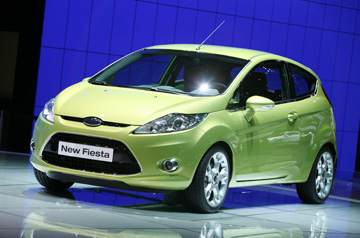
DEARBORN, MI – Ford Motor Co.’s North American products have been “inconsistent” in the past, and the auto maker is working toward better aligning the DNA of its global lineup, a top engineer says.
Ford of Europe has been striving to create a common look, sound and feel to its vehicles for years, and the results have been “astonishing,” says Larry Kummer, manager-vehicle integration.
“Europe’s been doing this DNA stuff for 10 years, and it’s starting to pay off there,” he tells Ward’s during a media event here. “Our market share is coming back (in the region). Customers and the automotive press expect that DNA to be delivered consistently, and we do.”
Ford’s primary objective today is to make its vehicles recognizable to customers in all world markets, he says, describing the effort as “creating a personality and giving our vehicles some character.”
These range from the sound of a car door closing and the chimes that remind drivers to buckle-up to the feel of the brakes and the audible quality of the powertrain.
Work on the project accelerated with the 2006 appointment of Derrick Kuzak as group vice president-global product development. Prior to that, he served as vice president-North America engineering, following a long stint as vice president-product development for Ford of Europe.

In Europe, Kuzak helped craft Ford’s DNA strategy and brings invaluable experience in assisting the North American team in aligning products here with those in other regions of the world, Kummer says.
“Derrick did this for a long time in Europe, and we (started) copying them about three years ago,” Kummer says. “But it really never got the traction that we have now that Derrick’s here. The imperative we have to start engineering products globally has driven a lot more attention to that (goal).”
Although the main objective is to commonize all global products, there will be regional differences, Kummer says, citing the upcoming Fiesta B-car as one example of where there will be slight variations to accommodate different types of driving styles and customer expectations.
“When I drive to work, I drive straight for five miles (8 km) turn right and drive straight again,” he says. “In Europe, you don’t do that, so there’s obviously different driving characteristics.”
To accommodate regional differences, the Fiesta’s brakes and driving dynamics will vary, because drivers in Europe like a firmer ride while North American consumers prefers a cushier feel.
At the same time, Ford engineers are being careful not to overcorrect for regional differences, “so we don’t get a European product that tastes like chocolate and one engineered in North America that tastes like vanilla,” Kummer says.
Ford’s DNA strategy also allows the streamlining of new product-development programs, he says. For instance, engineers don’t have to concern themselves with figuring out how the door will close or what brakes to install. Plus, using a greater number of common parts leads to economies of scale, resulting in cost savings.




